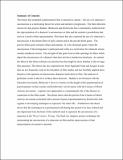| dc.contributor.advisor | Ryder, Sean | |
| dc.contributor.advisor | Stoneman, Rod | |
| dc.contributor.author | Johnson, Veronica | |
| dc.date.accessioned | 2013-07-26T16:38:58Z | |
| dc.date.issued | 2013-06-04 | |
| dc.identifier.uri | http://hdl.handle.net/10379/3559 | |
| dc.description.abstract | Summary of Contents
This thesis has examined a phenomenon that is unusual in cinema - the use of a character's unconscious as a motivating factor for action and narrative progression. The three directors chosen for this project; Buñuel, Hitchcock and Kieslowski have consistently explored both the representation of a character's unconscious on film and the narrative possibilities that arise as a result of that representation. This thesis has also explored the use of a character's unconscious in the dream films of early cinema and in the psycho-killer genre. The psycho-killer genre remains robust and popular. It is the dominant genre where the unconscious of the protagonist is portrayed and works as a motivation for character action, usually murderous action. The strength of this genre leaves little openings for films which depict the unconscious of a character that does not have murderous intentions. In contrast the films in this thesis reference an unconscious that might be more familiar to the average film spectator. This thesis has also explored texts from Sigmund Freud and Jacques Lacan that are not frequently used in the discipline of film studies and has fruitfully applied these theories to the question of unconscious character motivation in film. The analysis of particular events in the lives of these three directors - Buñuel's involvement with the Surrealist movement, Hitchcock's move to America at the height of the popularisation of psychoanalysis in that country and Kieslowski's involvement with the Cinema of Moral Anxiety movement - explores new approaches to examining the life of the director in connection to the films made. This thesis shows that the period of the Cinema of Moral Anxiety movement coincided with a period of great experimentation by Kieslowski with regards to developing techniques to represent "the inner life". Furthermore this thesis shows that the techniques he experimented with during this period were later refined and developed and were the basis of the methods used to represent the unconscious of a character in the Three Colours: Trilogy. The final two chapters analyse techniques for representing the unconscious of a character on film and the repercussions of that representation on narrative structure. | en_US |
| dc.rights | Attribution-NonCommercial-NoDerivs 3.0 Ireland | |
| dc.rights.uri | https://creativecommons.org/licenses/by-nc-nd/3.0/ie/ | |
| dc.subject | Character's unconscious | en_US |
| dc.subject | Film directors | en_US |
| dc.subject | Luis Bunuel | en_US |
| dc.subject | Alfred Hitchcock | en_US |
| dc.subject | Krzysztof Kieslowski | en_US |
| dc.subject | English and Huston School of Film | en_US |
| dc.title | The Representation and Narrative Function of a Character's Unconscious in the Films of Luis Bunuel, Alfred Hitchcock and Krzysztof Kieslowski | en_US |
| dc.type | Thesis | en_US |
| dc.contributor.funder | IRCHSS | en_US |
| dc.description.embargo | 2017-06-04 | |
| dc.local.final | Yes | en_US |
| nui.item.downloads | 1235 | |


